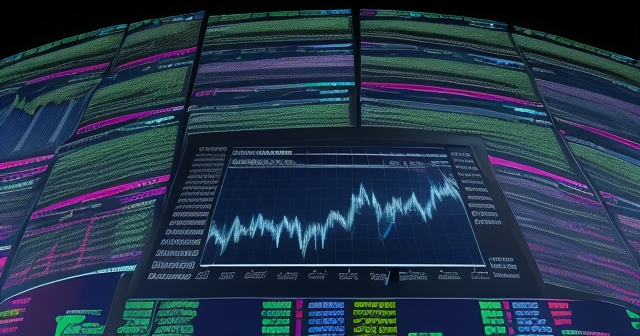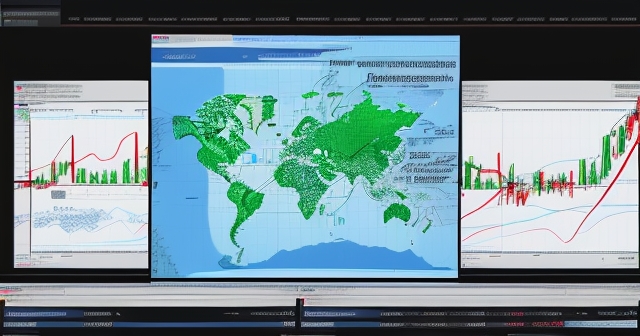“`html
Mastering Index Trading in Australia: A Deep Dive into the S&P/ASX 200
Welcome, future index trading expert! If you’re navigating the Australian share market or looking to deepen your understanding of its key benchmark, the S&P/ASX 200 Index is where much of the action happens. As your guide, we’ll embark on a journey to dissect this vital index, understanding its mechanics, recent performance, and the powerful forces that shape its movements. Trading indices offers a unique way to participate in the broader market without picking individual stocks, but it requires a solid understanding of the underlying dynamics.
Think of the S&P/ASX 200 as the pulse of the Australian stock market – a single number reflecting the collective health and sentiment surrounding the nation’s 200 largest listed companies. But like any pulse, it’s influenced by myriad internal and external factors. To trade it effectively, whether through direct exposure or derivative instruments, you need to look beyond just the number and understand the engine driving it. Are you ready to build that foundational knowledge?

Below are some essential aspects to consider when trading the S&P/ASX 200:
- Understand the components and sectors impacting the index.
- Monitor macroeconomic indicators that contribute to market sentiment.
- Use analytical tools and strategies for informed decision-making.
Understanding the S&P/ASX 200: Australia’s Benchmark Explained
What exactly is the S&P/ASX 200 Index? At its core, it is defined as Australia’s benchmark share market index. It represents the performance of the 200 largest companies by float-adjusted market capitalisation listed on the Australian Securities Exchange (ASX). It is a free-float market-capitalisation weighted index, meaning companies with larger market values have a greater impact on the index’s overall level.
This index isn’t static. Its composition is reviewed and updated quarterly by S&P Dow Jones, typically in March, June, September, and December. During these quarterly rebalances, companies might be added or removed based on changes in their market capitalisation and liquidity, ensuring the index continues to accurately reflect the large-cap segment of the Australian market. Understanding this structure is fundamental because changes in the top constituents or shifts in sector weighting can significantly influence the index’s behaviour.
Why focus on the ASX 200 for trading? For many investors and traders interested in the Australian market, it offers broad exposure. Instead of analyzing hundreds of individual companies, you can analyze the macroeconomic landscape, sector trends, and the performance of the largest players to form a view on the index’s direction. This makes it a popular instrument for both long-term investment strategies and shorter-term trading tactics.

Recent Performance Analysis: Navigating Volatility
Let’s look at the S&P/ASX 200’s recent performance, which provides a snapshot of current market sentiment and pressures. We’ve seen some interesting movements lately. For instance, the index recently experienced a notable decline, closing one particular Friday session down 0.33% at 7,724. While seemingly a modest daily dip, this contributed to a larger picture: a 1.73% weekly loss. This marked the index’s worst weekly performance since mid-April, highlighting the presence of significant downward pressure during that period.
What drove this recent weakness? A closer look reveals that key sectors and major companies were under pressure. Large-cap financial stocks, including major banks like Commonwealth Bank (CBA) and Westpac Banking (WBC), were among the notable decliners in the session that capped the weak week. Simultaneously, gold stocks such as Northern Star Resources (NST) and Evolution Mining (EVN) also saw declines, contributing to the overall index fall. This illustrates how performance in the index’s largest constituents, particularly within its dominant sectors, directly translates into the index’s movement.
This recent volatility serves as a crucial reminder for index traders. Even within an overall positive trend (which we will discuss), pullbacks and significant weekly losses are part of the market cycle. Identifying which sectors or major stocks are leading these moves can offer valuable insights into the underlying reasons for the index’s direction and help inform your trading decisions.

Year-to-Date Trends and Historical Context: A Broader Perspective
While recent performance shows volatility, it’s essential to place it within a broader historical context. Looking at the year-to-date performance provides a different perspective. Despite the recent weekly decline, the S&P/ASX 200 has generally shown resilience. Since the start of 2024, the index has recorded a gain of 1.76% (based on the specific data period). This demonstrates that the overarching trend for much of the year has been positive, absorbing various market shocks and maintaining an upward trajectory.
Crucially, 2024 saw the S&P/ASX 200 reach a significant milestone: an all-time high of 7919.60 points achieved in April 2024. Reaching a historical peak is a powerful indicator of market strength and investor optimism at that time. It reflects a period where positive factors, whether domestic or global, outweighed negative pressures, pushing valuations higher across the board.
Understanding these historical levels is important for technical analysis. All-time highs or significant recent highs can act as points of reference for traders, potentially serving as resistance levels in the future if the index attempts to re-test them. Conversely, previous areas of strong support or resistance can also provide context for current price action. Comparing recent dips to the overall year-to-date gain and the historical high helps you gauge the significance of short-term movements within the longer-term trend. Are we seeing a minor correction within a strong trend, or is the market sentiment fundamentally shifting?
Macroeconomic Influences: Global Forces Shaping the ASX 200
Index trading in Australia is far from being solely influenced by domestic events. The S&P/ASX 200 operates within a globally interconnected financial system, making international macroeconomic factors incredibly influential. One of the most significant drivers currently comes from the United States, particularly concerning monetary policy and inflation.
US Inflation data, such as the Consumer Price Index (CPI), is closely watched by markets worldwide. Cooler-than-expected US inflation figures can significantly boost market sentiment globally, including on the ASX. Why? Because lower inflation reduces the pressure on the US Federal Reserve (the ‘Fed’) to keep interest rates high or raise them further. Expectations around the Federal Reserve interest rate forecasts are a major determinant of global risk appetite. Revised forecasts suggesting potential rate cuts or a pause in hikes can make riskier assets like stocks more attractive compared to bonds, leading to capital inflows or increased buying pressure.
Beyond monetary policy, international trade relations also play a role. Developments in areas like US-China trade talks and changes in tariffs can impact sectors heavily reliant on global trade or exports, such as Australia’s significant Materials sector. Positive developments can remove uncertainty and support related stocks, while negative news can create headwinds.
Furthermore, actions by other major central banks, such as the People’s Bank of China (PBOC) rate cuts, can also have a positive impact on the ASX, particularly for companies with significant exposure to the Chinese economy (like many mining companies). Understanding these global macro forces is not just an academic exercise; it’s crucial for predicting potential shifts in the market sentiment that will inevitably ripple through to the S&P/ASX 200.

Domestic Policy and Economic Indicators: The RBA’s Role
While global factors are potent, domestic policy, particularly from the Reserve Bank of Australia (RBA), is arguably the most direct influence on the Australian market’s direction. The RBA’s decisions on the cash rate are central to the Australian economic outlook and directly impact borrowing costs, inflation expectations, and overall consumer and business confidence.
Leading up to recent RBA policy meetings, the prevailing expectation has been for the central bank to hold the cash rate at 4.35%. However, the narrative is often nuanced. The RBA might maintain the current rate but retain a hawkish stance, meaning they are still prepared to raise rates if inflation risks persist or intensify. This ‘not ruling out future hikes’ adds a layer of uncertainty to the market, as it suggests the door is still open for further tightening, which can weigh on stock valuations, particularly for growth stocks and those sensitive to borrowing costs.
Investors are also keenly awaiting domestic economic data releases. Figures on Australian consumer inflation expectations and consumer confidence for key periods (like June, based on the provided data context) are vital indicators. High consumer inflation expectations can put pressure on the RBA to act, while low consumer confidence can signal potential weakness in spending and economic growth. These data points provide clues about the health of the Australian economy and influence market participants’ expectations regarding future RBA actions.
Trading the index effectively involves synthesizing these domestic signals with the global picture. The interplay between expected RBA actions (hold vs. hike), domestic economic health, and the backdrop of global monetary policy expectations creates a complex environment that requires careful monitoring.

Composition and Sectoral Deep Dive: What Drives the ASX 200 from Within?
To truly understand how the S&P/ASX 200 moves, you must look at its internal structure – its composition by sector. The index is not evenly balanced across all parts of the economy. Instead, it is heavily weighted towards specific sectors, making their performance particularly impactful.
The Financials sector constitutes nearly a third of the index, making it the largest component by a significant margin. This includes the major banks (CBA, Westpac, NAB, ANZ), insurance companies (IAG, QBE, Suncorp), and other financial services firms (Macquarie Group). Given their large weight, the performance of these companies – influenced by interest rates, lending growth, asset quality, and regulatory changes – has a dominant effect on the overall index level. When banks perform poorly, the index is likely to follow suit, as seen in recent declines.
The Materials sector is the second largest component. Australia is a major global producer of commodities, and this is reflected in the index’s composition, with giants like BHP Group (BHP), Rio Tinto (RIO), and Fortescue Metals Group (FMG) featuring prominently. The performance of the Materials sector is highly sensitive to global commodity prices (iron ore, gold, copper, etc.) and demand, particularly from China. Therefore, global economic growth forecasts and commodity price movements are crucial drivers for a significant portion of the index.
While other sectors like Health Care (CSL), Consumer Discretionary (Wesfarmers), Industrials, and Energy (Woodside Energy) are also represented and important, their combined weight is less than that of Financials and Materials. This means that a strong performance in Financials or Materials can often offset weakness elsewhere, and vice versa. Analyzing sector-specific news, trends, and global commodity markets is therefore indispensable for anyone trading the ASX 200.
| Sector | Weight in ASX 200 (%) |
|---|---|
| Financials | 30% |
| Materials | 25% |
| Health Care | 10% |
| Consumer Discretionary | 8% |
| Industrials | 7% |
Methods for Trading the S&P/ASX 200 Index
Now that we’ve discussed the index itself and its drivers, how can you actually trade it? There are several common methods, each offering different levels of exposure, leverage, and complexity.
The most direct, though perhaps less common for pure index exposure, is buying individual shares of the companies listed on the ASX 200. While you won’t perfectly replicate the index’s performance (due to weighting and transaction costs), investing in a diversified portfolio of the largest constituents gives you exposure to the same market segment. This method involves traditional stock brokerage accounts and ownership of underlying assets.
A popular and efficient way to gain exposure to the S&P/ASX 200 is through Exchange Traded Funds (ETFs). Index-tracking ETFs hold a portfolio of stocks designed to replicate the performance of the S&P/ASX 200, often with very low management fees. When you buy a share of an ASX 200 ETF, you are essentially buying a tiny piece of all 200 companies in the index. ETFs are traded on the stock exchange just like regular shares, making them easy to buy and sell. They are generally suitable for investors seeking long-term exposure with lower risk compared to leveraged products.
Another method, often favoured by shorter-term traders or those seeking leveraged exposure, is trading Contracts For Difference (CFDs) on the S&P/ASX 200 index. CFDs are derivative instruments that allow you to speculate on the price movement of the index without owning the underlying assets. When trading an index CFD, you enter into a contract with a broker based on whether you believe the index price will rise or fall. The profit or loss is the difference between the opening and closing price of the contract, multiplied by the number of contracts traded.
CFDs offer leverage, meaning you can control a large position with a relatively small amount of capital (margin). This can amplify profits but also significantly amplify losses. CFDs are available through dedicated CFD brokers and often come with features like the ability to easily go ‘short’ (profit from falling prices) and can be traded outside traditional market hours depending on the broker. Understanding the risks associated with leverage is crucial before trading CFDs.
When considering trading methods, especially CFDs, the choice of platform and broker is paramount. These instruments are typically traded through online brokers, and choosing the right platform is crucial for execution speed, available tools, and reliable market data. If you’re considering beginning your journey with leveraged products like CFDs or exploring various other financial instruments, finding a platform that aligns with your needs is vital. Moneta Markets is an option worth considering. As an Australian-origin platform, it offers a wide range of financial instruments, potentially including index CFDs, alongside other assets like forex, making it a versatile choice for both beginners and more experienced traders looking for diverse trading opportunities.
Each trading method has its pros and cons related to capital requirements, risk profile, trading hours, and fees. Your choice will depend on your investment goals, risk tolerance, and trading strategy.
Market Sentiment and Key Drivers: Reading the Signals
Market sentiment – the overall attitude of investors towards an asset or market – is a powerful, though sometimes intangible, force driving index movements. It’s influenced by a complex interplay of the factors we’ve discussed: macroeconomic data, central bank actions, corporate earnings, and global events.
For the ASX 200, sentiment is currently being shaped by balancing acts. On one hand, cooler US inflation data provided a positive boost in some sessions, alleviating fears of aggressive global monetary tightening. This suggests that some market participants are becoming more optimistic about the global growth outlook or the possibility of eventual rate cuts.
On the other hand, the persistent sticky US inflation data and the Federal Reserve’s revised forecasts, which might signal fewer rate cuts than initially hoped for, continue to fuel market fears. One such fear is that of stagflation – a difficult economic scenario combining high inflation with low economic growth. Such fears can lead to defensive positioning among investors, potentially favouring less cyclical sectors or assets over broad index exposure.
Moreover, analysts often highlight the difference between ASX and Wall Street market dynamics. While the ASX is influenced by global trends, its heavy weighting in financials and materials gives it a different sensitivity profile compared to the tech-heavy US indices like the Nasdaq or the broader S&P 500. Investors sometimes overlook these differences, applying Wall Street logic to the ASX when it may not fully apply, particularly regarding sector-specific risks and opportunities.
Reading market sentiment involves paying attention not just to the data itself, but also to how the market reacts to it. Are gains sustained after positive news? Are dips bought into quickly, or do they deepen? Observing these reactions, alongside tracking the key economic indicators and policy signals, helps you gauge the prevailing mood and potential future movements of the index.
Future Outlook and Forecasts: What Lies Ahead?
Predicting the future direction of any market, including the S&P/ASX 200, is inherently challenging. However, market participants and analysts regularly provide forecasts based on their analysis of current conditions and expected future developments. These forecasts are not guarantees but offer potential scenarios and price targets based on macroeconomic models and market expectations.
Based on some macroeconomic models (such as those cited by Trading Economics), the forecast for the Australia Stock Market Index suggests a potential modest decline from recent levels over the coming periods. For instance, one model forecasts the index to trade at approximately 7656.26 points by the end of the current quarter and project it to be around 7521.48 points in 12 months. These figures, while relatively close to current levels, suggest a potential period of slight retracement or consolidation rather than a strong upward surge based on these specific models.
What factors underpin such forecasts? They typically incorporate expectations regarding future economic growth, inflation trends, interest rate paths (both RBA and global), corporate earnings outlooks, and geopolitical developments. A forecast for a slight decline might imply expectations of ongoing inflationary pressures limiting the scope for RBA rate cuts, potential softness in commodity demand, or general global economic headwinds.
However, it’s crucial to remember that forecasts vary widely among institutions and are subject to change as new data emerges. Geopolitical surprises, unexpected shifts in central bank policy, or significant changes in commodity markets can quickly render previous forecasts obsolete. For traders, these forecasts serve less as definitive targets and more as inputs into their own analysis, helping them understand the potential range of outcomes and the key assumptions driving market expectations.
Integrating Analysis for Informed Trading Decisions
To trade the S&P/ASX 200 effectively, you need to integrate the various pieces of analysis we’ve discussed. This means combining an understanding of the index’s structure, its recent performance history, the influence of global and domestic macroeconomic factors, and the prevailing market sentiment.
For instance, if you see weak performance in the Financials sector coinciding with hawkish comments from the RBA, this aligns with an expectation that higher interest rates could pressure bank margins or loan growth. Similarly, if the Materials sector is underperforming while iron ore prices are falling due to concerns about China’s economy, this confirms the direct link between commodity markets and this key index component.
Technical analysis can also be applied to the index’s price chart itself. Historical highs like the 7919.60 level can become significant resistance points. Previous lows during pullbacks might form support levels. Chart patterns, indicators (like moving averages, RSI, MACD), and volume analysis can be used to identify trends, potential reversals, and entry/exit points, but it’s most powerful when used in conjunction with fundamental and macroeconomic analysis.
For traders utilising platforms to access the market, having tools that integrate charting capabilities with real-time news feeds and economic calendars can be invaluable. This allows you to see how price action responds to key data releases or policy announcements directly on your trading interface. Many modern trading platforms, such as those supporting MT4, MT5, or Pro Trader, offer these integrated features, which are essential for informed decision-time decision-making. When you are exploring which brokerage aligns best with your analytical approach and trading style, the technological capabilities and data access provided are crucial considerations. Moneta Markets, which offers support for popular platforms like MT4 and MT5, combined with features designed for efficient trading such as potentially low spreads and fast execution, presents a robust environment for implementing strategies based on both fundamental and technical analysis of indices and other assets.
Developing a trading plan that outlines your strategy based on your integrated analysis, including your risk management rules (like stop-loss orders), is crucial for disciplined index trading.
Risks and Considerations in Index Trading
Like all forms of financial trading, trading the S&P/ASX 200 Index comes with risks. Understanding these risks is just as important as understanding the potential opportunities.
-
Market Risk: The value of the index can fall due to broad market downturns caused by economic recessions, geopolitical events, or shifts in sentiment. This is the fundamental risk of being exposed to the market.
-
Sector Concentration Risk: Due to the heavy weighting of Financials and Materials, the index is particularly vulnerable to negative developments within these specific sectors, even if the broader economy is performing well.
-
Interest Rate Risk: Changes in the RBA cash rate significantly impact the Financials sector and the broader economy, influencing the index’s performance.
-
Commodity Price Risk: Fluctuations in global commodity prices directly affect the Materials sector, introducing volatility.
-
Liquidity Risk: While the ASX 200 itself is highly liquid, certain trading methods (like CFDs) carry counterparty risk with the broker. ETFs are generally very liquid during market hours.
-
Leverage Risk (for CFDs): Using leverage can magnify both profits and losses. A small adverse movement in the index can result in a significant loss that exceeds your initial margin deposit. It is possible to lose more than your initial investment when trading leveraged products like CFDs.
-
Platform and Execution Risk: The reliability and speed of your trading platform and broker can impact your ability to enter and exit trades at desired prices, particularly during volatile periods.
Effectively managing these risks is paramount. This includes setting appropriate position sizes, using stop-loss orders to limit potential losses, diversifying if possible (though index trading itself is a form of diversification across 200 stocks), and only trading with capital you can afford to lose, especially when using leverage.
Conclusion: Your Path Forward in ASX 200 Index Trading
In conclusion, the S&P/ASX 200 Index is a fascinating and dynamic benchmark, serving as the primary gauge for the Australian share market. We’ve explored its definition, the drivers behind its recent volatility and year-to-date gains, the significant influence of both global macroeconomic forces (like US inflation and the Federal Reserve) and domestic policy (the RBA’s cash rate), and the critical role of its dominant sectors, Financials and Materials.
We’ve also touched upon the various methods available for trading this index, from direct share ownership and ETFs offering broad, lower-risk exposure, to CFDs providing leveraged opportunities for speculating on price movements. Each method requires careful consideration based on your individual trading goals and risk tolerance.
For those engaging in index trading in Australia, continuously monitoring global policy shifts, domestic economic indicators, key sectoral movements, and major company news is absolutely essential. Integrating this fundamental and macroeconomic analysis with technical charting and risk management strategies will equip you to navigate the complexities of the current market environment and identify potential trading opportunities.
Remember, becoming proficient in index trading, like mastering any skill, requires continuous learning, practice, and discipline. By understanding the engine behind the S&P/ASX 200 and the forces that move it, you are building a solid foundation for making more informed decisions on your trading journey. Stay curious, stay analytical, and approach the market with respect for its inherent uncertainties.
index trading australiaFAQ
Q:What is the significance of the S&P/ASX 200 Index?
A:The S&P/ASX 200 Index is a benchmark for the Australian share market, reflecting the performance of the 200 largest companies listed on the Australian Securities Exchange.
Q:Which sectors have the most influence on the ASX 200?
A:The Financials and Materials sectors are the most influential, making up a significant portion of the index’s composition and impacting its overall performance.
Q:How can I trade the ASX 200 Index?
A:You can trade the ASX 200 Index through methods like buying ETFs, trading individual shares of component companies, or using Contracts For Difference (CFDs).
“`

留言